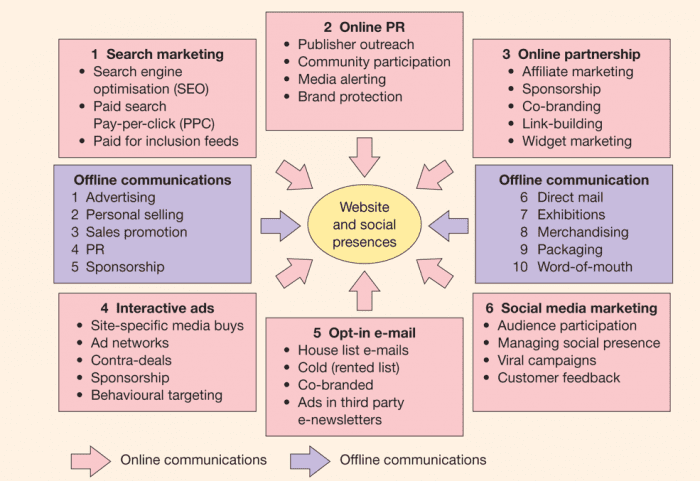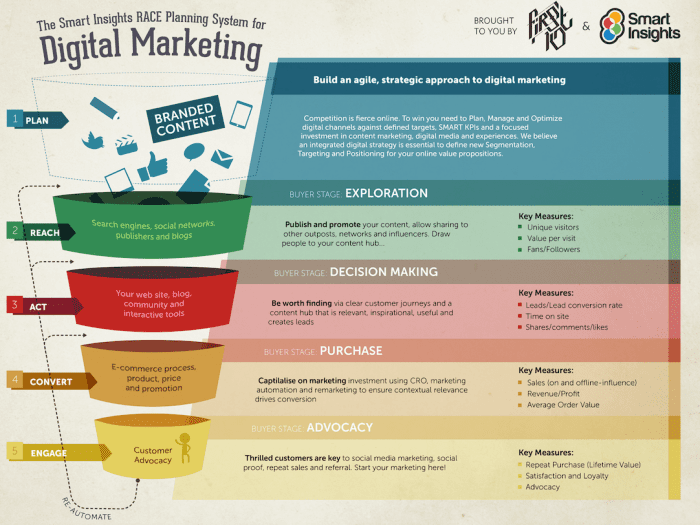What are the essential parts of a campaign plan template?
The purpose of a marketing campaign plan is to identify relevant, integrated, marketing activities and channels to reach campaign objectives as well as influence customers. An effective campaign plan has an engaging, shareable, campaign concept which utilizes both online and offline marketing communications tools and digital media channels.
As outlined in our Quick Win – Create a Multi-Channel Marketing Plan, a marketing campaign plan is a shorter-term integrated communications plan for using different digital media to hit lead or sales targets. Its purpose is to engage audiences, it typically has a content marketing focus and an integrated media schedule.
A solid marketing campaign plan has:
- Clear, realistic goals which you can be confident of hitting
- The best strategy to achieve these goals against your competition
- Sufficient details of the tactics and actions needed to translate the strategy into action
- A method to check you are on track with your plans
When to use a marketing campaign plan?
Your marketing campaign plan should be used in order to maximize the reach of online campaigns and acquire new customers. Retention campaigns are used in larger organizations. Campaigns should be used and designed with specific goals in mind, such as:
- A branding campaign to build brand awareness, favourability, and familiarity
- Launching a new product
- Distributing a new content asset as part of a content marketing lead generation initiative
- Increasing sales of a current established product
- Promotional campaigns to increase sales by offering a seasonal discount
Defining a campaign’s goal will determine your plan’s use and which marketing channels will be most effective.
How should a campaign plan be structured?
A campaign plan should be structured around the six areas summarized below. These have been defined in the Smart Insights Marketing campaign plan template.
The stages of marketing campaigns and key issues that need to be included in your campaign plan are:
- Campaign goals and tracking.
What are we trying to achieve through our campaign and how will we know when we achieve it? - Campaign insight and targeting.
Who are we trying to reach and influence? - Key campaign messages and offers.
How are we trying to position our company, products and services?
Which campaign or product offers will engage and convert our audience? - Campaign media plan and budget.
Which media channels will you use to reach and influence your target audience?
What will be the sequence and integration of media activities? - Campaign asset production.
Managing the assets to form the campaign - Campaign execution.
What needs to be tested before the campaign is live and adjusted during the campaign?
Across each of these six stages, a campaign plan typically includes defining:
- Relevant customer profiles or personas to target
- The value proposition of the product or service
- The primary or hero offer which is the call to action (CTA)
- The promotional channels for raising awareness and encouraging action
- How website landing pages and customer journeys will feature the offer
- The timeline and action plan
- The budget required
- The mechanics for how leads generated will be nurtured and followed up through offers
- How results will be measured and reported
Applying SOSTAC® to campaign planning
Although PR Smith’s SOSTAC® framework works best for business and marketing plans, as I show here, it’s a versatile tool which can be applied to campaign planning too.
To make sure your marketing campaign plan has all the essential features, I recommend the SOSTAC® structure developed by PR Smith—Dave Chaffey’s co-author of the printed book Digital Marketing Excellence. SOSTAC® is a great framework for structuring business, marketing or digital marketing plans since it’s relatively simple and logical, so it’s easy to remember and to explain to colleagues or agencies. SOSTAC® is a strategic planning process framework that gives you a clear structure to work through to create and manage your plan.
So, what does SOSTAC® stand for?
Situation analysis means ‘Where are we now?’ For marketing campaign planners, questions include:
- Who are our target customers?
- What are their typical characteristics?
- What campaigns have been used by our competitors?
- How are they meeting the needs of our target customers?
- Which creative and messaging tactics are they using?
- How can we achieve differentiation?
- Which data about customer and competitor behaviour is available to inform our campaign?
Objectives mean ‘Where do we want to be?’
- What are the SMART campaign goals including number of leads and sales based on reach?
- What are we trying to achieve through our campaign and how will we know when we achieve it?
- Is our focus customer acquisition, retention and growth or creating brand awareness?
- What are the timescales?
- Who are we trying to reach and influence?
- Which are the customer personas?
- Which customer insights are these based upon?
We recommend you create a conversion-based campaign forecasting model for your campaign so you can be more confident that it will reach the audience needed to give the required levels of business outcomes, i.e. leads and sales.
Strategy means ‘How do we get there?’ Strategy summarizes how to fulfil the objectives. It is the shortest part of the plan, but arguably, the most important, as it gives direction to all the subsequent tactics. It answers questions including:
- What are our campaign messages and offers?
- Which campaign or product offers will engage and convert our audience to the goals identified?
- How will we connect with and convince our audience using content marketing?
- How will we position our company, products and services?
Tactics are the details of strategy. They highlight on a marketing campaign plan exactly which tactics occur when. Your chosen tactics should support and adhere to your customer’s journey. Questions include:
- What is our media plan and budget?
- Which media channels will we use to reach and influence our target audience?
- What will be the sequence and integration of media activities?
To help you plan your campaign tactics effectively, the RACE Planning system will provide you with a simple framework as explained in the next section.
To drive reach online to achieve your campaign goals I recommend you consider these 6 options defined in this diagram. In reality, you will specify more detail for each channel as listed in our Digital media cheatsheet which gives a succinct summary of the main organic and paid media options on Google and in the social network.
Action is the detailed planning of tactics.
- Who does what, when and how?
- What processes and activities are required to make things happen?
Control identifies what you need to measure when and what happens. The Control section of the plan ensures you know if you are succeeding or failing – and you can make adjustments– before it is too late. How you measure the success of your marketing campaign activities will be based upon the overall marketing objectives detailed in your marketing plan.
Why use RACE for planning campaigns
RACE is a practical framework to help manage and improve results from your digital marketing. Ultimately, it’s about using best practice across digital marketing techniques to get more commercial value from investments in digital marketing. It will help simplify your approach to reviewing the performance of your marketing campaigns and taking actions to improve their effectiveness.
Although SOSTAC® provides a superb framework for structuring a plan, I recommend that a marketing campaign plan combines it with the Smart Insights RACE planning framework since:
- RACE is practical and action-oriented – it focuses on tactics you can implement in your marketing communications and on your website and mobile apps
- RACE is customer-centred – it follows the established customer lifecycle of relationship building or marketing funnel from creating awareness; generating leads from new prospects; converting prospects to sell online or offline and encouraging loyalty, repeat sales and advocacy such as social sharing.
- RACE integrates performance evaluation – It defines KPIs that marketing campaign planners should include at each stage for setting targets and reviewing results using analytics and summary dashboards.
What is RACE?
RACE covers the full customer lifecycle or marketing funnel from acquisition to retention as shown in this infographic showing the goals for each part of RACE and how you can measure them.
(Plan) > Reach > Act > Convert > Engage
There is also an initial phase of Plan involving creating the overall digital strategy, objective setting and plan.
RACE consists of four steps or online marketing activities designed to help brands engage their customers throughout the customer lifecycle.
- Reach.
Reach involves building awareness and visibility of your brand, products and services on other websites and in offline media in order to build traffic by driving visits to different web presences like your main site, microsites or social media pages. It involves maximizing reach over time to create multiple interactions using different paid, owned and earned media touchpoints. - Act.
Act is short for Interact. It’s a separate stage from conversion since encouraging interactions on websites and in social media. For most businesses the main aim of Act is to generate online leads. So, it’s about persuading site visitors or prospects take the next step, the next Action on their customer journey when they initially reach your site or social network presence. It may mean finding out more about a company or its products, searching to find a product or reading a blog post.You should define these actions as top-level goals of the funnel in analytics. Goals can include “Viewed product”, “Added to Basket”, “Registered as member” or “Signed up for an e-newsletter. Act is also about encouraging participation. This can be sharing of content via social media or customer reviews (strictly, part of Engage). - Convert.
This is simply conversion to sale, online or offline. It involves getting your audience to take that vital next step which turns them into paying customers whether the payment is taken through online Ecommerce transactions, or offline channels. - Engage.
This is long-term customer engagement and communications that is, developing a long-term relationship with first-time buyers to build customer loyalty as repeat purchases using communications on your site, social presence, email and direct interactions to boost customer lifetime value. It can be measured by repeat actions such as repeat sale and sharing content through social media. We also need to measure the percentage of active customers (or email subscribers) and customer satisfaction and recommendation using other systems.
Which type of business is it most suited for?
Marketing campaign planning isn’t just for big marketing departments. Organizations of any size, type and at any stage of existence can utilize a marketing campaign plan in order to achieve an effective campaign. Today, with the wide use of content marketing by businesses, a campaign plan to launch your content makes campaign planning more relevant to all business.
A marketing campaign plan does not need to be lengthy or complicated. Creating a simple campaign plan with clear actions can ensure that both small and larger organizations are focusing on their goals and the overall success of the business.
How does it relate to other plans?
A marketing campaign plan is one small piece of your marketing plan; actions designed to achieve a particular objective. It is not produced regularly as part of an annual cycle, it is project or situation specific.
In contrast to a business plan, marketing plan, digital marketing plan and multichannel marketing plan, a campaign plan tends to have a limited duration to achieve defined objectives. It should integrate with, for example, your overall marketing plan, digital marketing plan and multichannel marketing plan to ensure full alignment.
from Blog – Smart Insights http://www.smartinsights.com/traffic-building-strategy/campaign-planning/structure-effective-campaign-plan/
via Tumblr http://euro3plast-fr.tumblr.com/post/166704115479


No comments:
Post a Comment